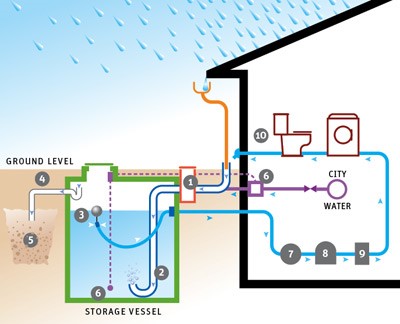Water-conserving Appliances and Technologies for Green building design applications
High levels of domestic water consumption also lead to high levels of energy consumption for heating, while also placing additional load on wastewater systems and sewage facilities. However, water consumption can be reduced by up to 50% through the following measures; adjustment of habits, installation of water- conserving devices and use of natural and renewable resources (rainwater and grey water).
The installation and use of water-conserving appliances also leads to a noticeable reduction in water consumption. The most important measures are:

- Lavatory flushes with economy switch/water saver fitting
- Water-conserving taps (single lever handle faucet) and shower fittings
- Public sector: fittings with infrared sensors
- Hot water in administrative buildings only to be supplied in kitchens and sleeping areas
- Waterless, no-flush urinals
- Dual flush water closets
Water conservation can also be applied to existing buildings if dripping taps and faulty toilet flushes can be avoided.
Rainwater Harvesting
Systematic rainwater utilization can reduce domestic water consumption by about half. Rainwater can be used for flushing, washing and cleaning, as well as for watering the garden. This requires a rainwater cistern and a second piping system. Since rainwater is soft, less washing powder is needed for the laundry. For watering the garden, rainwater is especially useful due to its high mineral content, which means that the plants like it better than regular domestic water.

Another advantage of rainwater use is that it takes load off the wastewater systems. Further, the cistern serves as a buffer for rainfall volume peak caps. For this reason alone, many new buildings now require rainwater collection.

Grey water is waste water from households, stemming from shower, bathtub, bathroom sink and the washing machine and which, hence, is not contaminated with faces or highly polluted kitchen waste water. It only contains a moderate amount of soap residue and skin oil. The average household produces about 60 liters of grey water per day, per person. This type of water can be processed into usable water, which is safe from a hygienic point of view but does not have the same quality as drinking water. It can be used for toilet flushing, watering and cleaning purposes. This means, in effect, that domestic water is then being used twice.
Grey water processing usually takes place through a biological and a mechanical process. Fine particles are filtered out. Afterward, the water is cleaned in the aerobe-biological stage and disinfected through UV radiation. These kinds of installations are already available on the market.
Impacts from landscaping can improve or impair quality of life. Landscaping affects water conservation, fire protection, soil erosion, storm-water management, health standards and recreation.
The largest use of all urban water is watering landscapes. When a landscape or irrigation system is poorly designed or poorly maintained, or the landscape consists of plants not suited to the dry and often hot climate, water demand increases as a result of excessive evaporation, leaks, and runoff. Water consumption can be greatly reduced with careful planning, good plant selection, efficient irrigation systems, and good water management and maintenance practices.

Proper design depends largely on a proper analysis of the different areas of the landscape. The most efficient irrigation systems divide the landscape into separate irrigation zones to accommodate different watering needs of plants.
Studies have shown that water-conserving landscapes, known as smart landscapes, can save significant water (50 percent or more) and reduce maintenance costs (up to 30 percent) by following appropriate planning principles, including the following:
- Designing for functionality
- Preparing soil properly
- Selecting plants suited for the climate of the region
- Using lawn appropriately
- Designing irrigation-systems for efficiency
- Employing appropriate maintenance practices
In short, plan and maintain the landscape with these principles of water efficiency in mind and it will continue to conserve water and be attractive.
